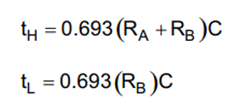Other Parts Discussed in Thread: TLC3555-Q1, ,
Tool/software:
Hi team,
My customer is using TLC555DR in their project. And they want the output frequency to keep from 155KHz to 220KHz. Customer wants to know how to keep the frequency in this limitation and would like to know the frequency offset of this device because they didn't find this spec in datasheet. Thanks!
BR,
Jiaqi



